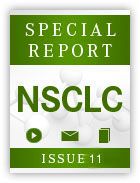Expert Explores Treatments for Biomarker-Negative Lung Cancer
The majority of patients with non–small cell lung cancer do not harbor an actionable marker, calling for future research into optimal therapies and combinations for patients with non-driver adenocarcinoma.
Corey J. Langer, M

Corey J. Langer, MD
The field of lung cancer has undergone dramatic changes, with a deluge of new therapies directed against ALK, ROS1, and EGFR; however, the majority of patients with nonsmall cell lung cancer (NSCLC) do not harbor one of these markers, calling for future research into optimal therapies and combinations for patients with non-driver adenocarcinoma, according to expert Corey J. Langer, MD.
“The vast majority of patients with advanced NSCLC, unfortunately, do not have oncogenic drivers,” Langer, professor of Medicine at the Perelman School of Medicine, director of Thoracic Oncology, at the University of Pennsylvania, toldTargeted Oncologyin an interview. “Those are confined to 20% to 30% of the group, and we have seen lots of promise for new agents based on the molecular target. However, the majority doesn’t have it.”
Although not a mutation, the recent CheckMate-026 study exploring frontline nivolumab (Opdivo) in NSCLC showed the importance of PD-L1 as a marker. In the CheckMate-026 study, those with PD-L1 expression on ≥1% of cells did not benefit from nivolumab compared with chemotherapy. This was in contrast to the KEYNOTE-024, which showed a benefit for pembrolizumab (Keytruda) in NSCLC expression PD-L1 on ≥50% of cells. These results further defined a group of patients without actionable drivers as those without PD-L1 expression.
In the interview, Langer provided insight into the current standard of care for patients without actionable markers and ongoing research exploring combination strategies, which include PD-1 inhibitors.
Targeted Oncology: Can you provide an overview of the current treatments used for non-driver NSCLC?
Langer: We’re still in the era of systemic cytotoxics, and here, too, we have made some headway. In the last 10 or 12 years, we have seen distinctions histologically with the role of pemetrexed (Alimta) and bevacizumab (Avastin) clearly secured for nonsquamous NSCLC phase III trials that have shown a survival advantage for those agents in combination with platinum-based agents or platinum therapies and other cytotoxics that have proven superior. Really, that is our platform for nonsquamous disease.
For squamous, it’s been a far greater challenge. There are phase III histology-based data that show, for instance, that gemcitabine and platinum is superior to pemetrexed and platinum. Therefore, gemcitabine is certainly one of our go-to agents for those with squamous histology. Taxanes have also proven superior to pemetrexed in the second-line setting in squamous, so taxanes are generally used upfront.
We do have very interesting data looking at nab-paclitaxel in combination with carboplatin, which, when compared to conventional solvent-based paclitaxel, has led to a significant improvement in response rate, although that hasn’t really translated into either a progression-free survival (PFS) or overall survival (OS) advantage in squamous cell NSCLC.
It should be noted that in individuals over 70, there was an advantage. Again, it’s a retrospective analysis. It’s only 150 patients or so, but about an 8- or 9-month difference favoring the nanoparticle-bound taxane over the conventional standard co-solvent cremophor-based molecule.
Are there other agents that may have a benefit in non-driver squamous NSCLC?
There are data in the second-line setting combining ramucirumab (Cyramza), which is an angiogenesis inhibitor that targets the receptor on endothelial cells, in combination with docetaxel. Clearly, there is a survival advantage compared with standard chemotherapy alone. This was observed not just in adenocarcinoma, but also in squamous cell. It’s certainly an option in the second-line setting, and we have compelling data for an EGFR monoclonal antibody necitumumab (Portrazza) in combination with the gemcitabine regimen, which has led to a survival advantage in the frontline setting.
What are some of the toxicities of some of these agents, either in combination or as monotherapies?
Pemetrexed compared with a taxane is generally less toxic. We don’t see the hair loss that’s typically associated with taxanesmuch less neuropathy—and there is virtually no neuropathy with pemetrexed. We do see some rash, and sometimes gastrointestinal toxicity or myelosuppression.
However, the routine use of vitamins, B12, and folic acid has really mitigated the toxicity of pemetrexed. Because necitumumab is an EGFR monoclonal antibody, rash is seen. You do see some hypomagnesaemia. There is some concern about increasing incidence of thromboembolic phenomena, although the incidence overall is quite low. For any drug such as ramucirumab or bevacizumab, you have to worry about bleeding. Endothelial cells are the targets, and we’ve seen both bleeding and blood clots with this class of agents. Patients need to be closely monitored for those effects.
What about combination therapy with immunotherapies?
There are ongoing studies pairing PD-1 inhibitors with other immunotherapy agents, including ipilimumab (Yervoy). The data are still very preliminary, but it does seem to combine fairly well with these other agents. Of course, you’re always worried about heightened immune-mediated toxicity.

Survivorship Care Promotes Evidence-Based Approaches for Quality of Life and Beyond
March 21st 2025Frank J. Penedo, PhD, explains the challenges of survivorship care for patients with cancer and how he implements programs to support patients’ emotional, physical, and practical needs.
Read More